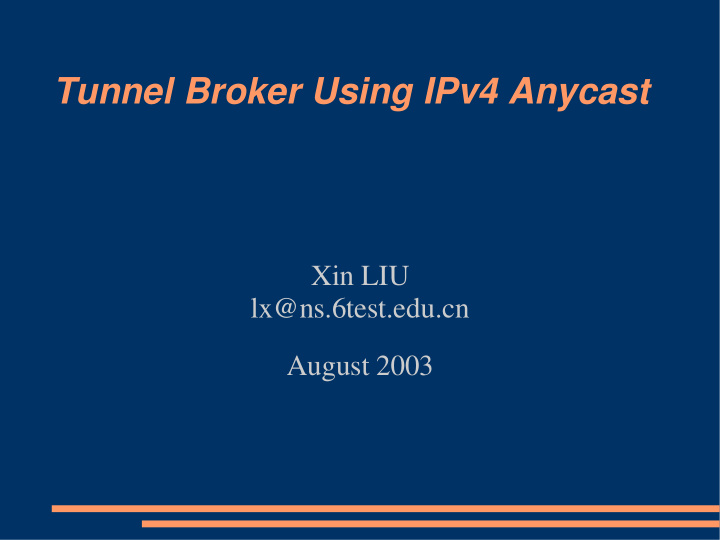



Tunnel Broker Using IPv4 Anycast Xin LIU lx@ns.6test.edu.cn August 2003
Outline ● Transition from IPv4 to IPv6 ● Typical Tunnel Broker ● Tunnel Broker Utilizing IPv4 Anycast
From IPv4 to IPv6 ● IPv6 = Internet Protocol Version 6 – Larger address space – Aggregated routing structure – Better auto-configuration – Better mobility support – Flow label – Better multicast support ● Transition will take a long time – IPv4 is widely used today – IPv6 could not intercooperate with IPv4
Islands in a Sea ● At the beginning of transition IPv6 Node IPv4 IPv6 IPv6 Node Node
IPv6/IPv4 Tunneling IPv4 IPv6 IPv6 Payload Header Header IPv6 IPv6 IPv6 Packet Packet Packet
Tunnel Management ● Tunnel setup requires manual configuration and administrators' cooperation ● Problems – High workload – Prone to errors – Low efficiency ● How to eliminate manual work of tunnel management? – Tunnel Broker – 6to4 automatic tunneling
Tunnel Broker ● RFC3053 ● Features – Working like a virtual ISP – Allocating IPv6 address blocks to users – Setting up IPv6/IPv4 tunnels for users – Optionally giving domain names to users
Typical Tunnel Broker System Tunnel Broker System TS DNS TB User TS IPv6/IPv4 Tunnel TS
Typical Tunnel Broker ( Cont'd ) ● Problems – Tunnel server selection – Fault tolerance
TB Utilizing IPv4 Anycast ● Principles – No special client software is required – A user attaches to a TS near him – Internal topology changes require no modification of user configuration – Hot potato routing
TB Utilizing IPv4 Anycast ( Cont'd )
TB Utilizing IPv4 Anycast ( Cont'd ) ● Tunnel Server selection
TB Utilizing IPv4 Anycast ( Cont'd ) ● Limitations – Pseudo-anycast – ICMPv4 and ICMPv6 – IPv4 routing system
The End
Recommend
More recommend